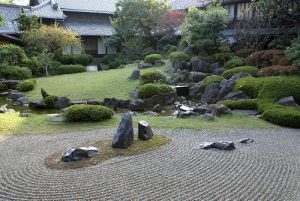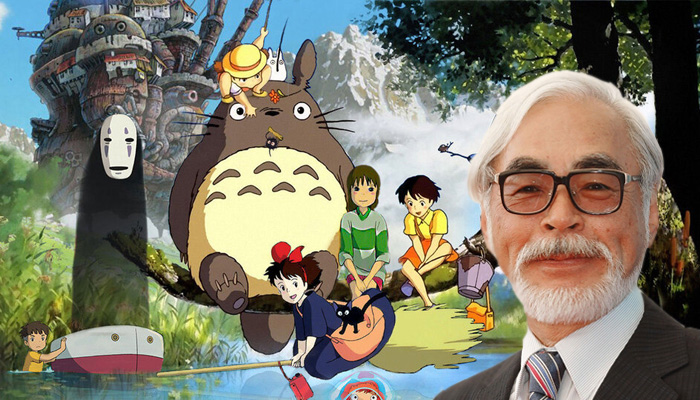What is the secret of the Japanese rock garden
 The mystery of the disappearing fifteenth stone is, perhaps, the first thing the European has associated with the traditional Japanese “dry” garden. However, neither the “invisible” stone, nor “Mount Fuji”, nor the sea of moss are mandatory elements of a rock garden, unlike the person for whom it is intended – a person.
The mystery of the disappearing fifteenth stone is, perhaps, the first thing the European has associated with the traditional Japanese “dry” garden. However, neither the “invisible” stone, nor “Mount Fuji”, nor the sea of moss are mandatory elements of a rock garden, unlike the person for whom it is intended – a person.
How stone gardens appeared in Japan
The Japanese Garden has come a long way of development – from luxurious spaces designed to entertain the nobility and decorate the residences of aristocrats, to hidden meanings of secluded and quiet corners for meditation. Like all primordially Japanese, the traditions of creating gardens came to the islands from China, eventually transforming into a distinctive and unique phenomenon. Buddhism played a decisive role here – the territories around the temples were organized so that they would facilitate meditation and unity with nature.
The first Japanese gardens, created according to new principles, arose in the VIII century. These were already spaces where the perfection of the surrounding nature was emphasized, and intervention in the natural landscape was limited only by the goals of the existence of such gardens – meditation, contemplation, detachment from fuss and human concerns.
The nature of Japan, especially the island of Honshu, where the traditions of the creation of the Japanese garden were born, is distinguished by its special beauty, diversity, variability depending on the season. It inspired the creators of the gardens to seek harmony between order and chaos, rules and spontaneity.
The first Japanese gardening guide, Sakuteiki, appeared in the 11th century. This manuscript was a record of a long-standing tradition that was transmitted orally from the previous generation to the next.
Since the XII century, Japanese culture has been influenced by Zen Buddhism, popular among samurai, the military aristocracy. And soon – from the XIV century, when the Muromachi period began – rock gardens, “kaersansuy” (dry mountains and waters), which were created at Buddhist temples, began to spread. The main purpose of the Japanese rock garden is to serve as a platform, a space for meditation, silent comprehension of the truth. According to Japanese philosophy, nature is the best way to promote self-knowledge.
It is believed that the first creators of the Japanese rock garden were inspired by Chinese monochrome landscapes
Some gardens have been preserved since ancient times, including the most, perhaps, the most famous in the world – the Reanji Garden in Kyoto.
This is one of those attractions that for a European tourist serves as a source of bewilderment and some curiosity, and for a Japanese – a precious cultural heritage. In the Reanji rock garden, located on the territory of a large temple complex, there are no trees, no shrubs, or ponds. A rather small space – a rectangular area thirty meters long and ten meters wide – is filled with white gravel and groups of large stones surrounded by moss.
There are fifteen black stones, as if they are on five islets surrounded by a “sea” of white gravel. With the help of a rake, the surface of the garden is brought into such a state that it resembles either a sea ripple or a wave – they surround each “island”; thin and frequent parallel grooves outline the main area. On one side of the garden is a terrace where visitors pass, on three sides it is surrounded by a clay fence.
The peculiarity of black stones is that no matter where the viewer is on the terrace, he always sees only fourteen stones. One is always out of sight. Having moved, you can see him, but at the same time, some other stone will become “invisible”. This is the main secret of the popularity of Reanji Garden – after all, this place offers tourists a real focus. But the true meaning of this effect, of course, is far from the goal of entertaining visitors.
From any point on the terrace you can see only fourteen large stones
There is no single explanation for the “secret of the fifteenth stone”, and everyone can offer their own interpretation of this phenomenon. According to an old legend, the fifteenth stone that is hidden from the eyes of a person is hidden in his soul, and therefore invisible. And only those who can soar above themselves, having attained spiritual enlightenment, can contemplate all the stones (indeed, you can see the fifteenth stone when looking at the platform from above). Perhaps still, the Japanese view of cognition is embodied in this way – no matter how much science opens, there will always remain that which is inaccessible to it.




